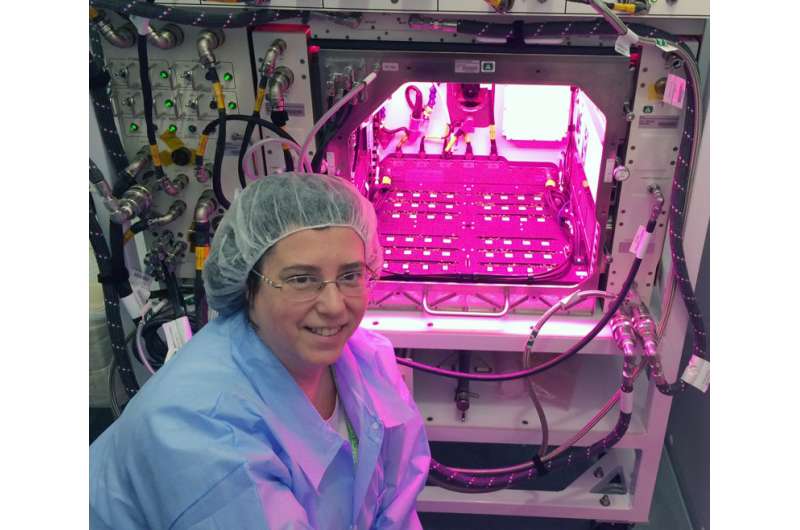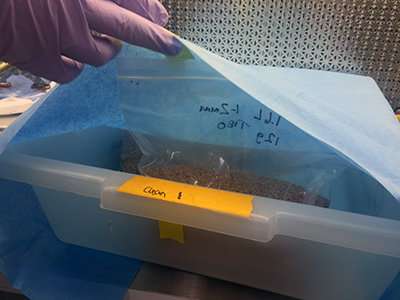Mary Lipton at Kennedy Space Center, in front of a duplicate of the plant habitat that will grow Arabidopsis plants on the International Space Station. Credit: Environmental Molecular Sciences Laboratory
Last month a rocket thundered off a NASA launch pad in Virginia, destined for the International Space Station. Nestled among the 7,400 lbs. of supplies was a handful of seeds designed to open new windows into our knowledge of how plants grow in space – information that could lead to growing fresh food in space for people aboard the space station or producing biofuel on our own planet.
The designer seeds were created in the laboratory of Norman Lewis, a Washington State University scientist who has led the many-year effort to get the seeds into space. Lewis's efforts finally paid off when a spacecraft blasted off from NASA's Wallops Flight Facility in the wee hours on May 21. It's the very first experiment to be conducted in NASA's advanced plant habitat – the most advanced environmental growth chamber ever in space – on the International Space Station.
The seeds will grow into the plant Arabidopsis, more commonly known as thale cress. The experiment puts the common weed, found often along the roadside or in cracks in the sidewalk, squarely at the forefront of space colonization. For if people are to embark on a years-long mission to Mars, they will need to grow fresh food along the way. To do that, we need to understand how plants grow in space.
Lewis is working with researchers at EMSL, the Environmental Molecular Sciences Laboratory, a Department of Energy Office of Science User Facility at Pacific Northwest National Laboratory. EMSL scientist Mary Lipton will lead the analysis of thousands of the plants' proteins to understand how the plants grown in space compare to counterparts grown in identical conditions – except for the force of gravity – back at Kennedy Space Center in Cape Canaveral, Fla.
The project has more than 180 sensors trained on the plants, taking detailed measurements of temperature, lighting, oxygen, carbon dioxide, moisture and other variables as the space station hurtles more than 17,000 miles per hour around Earth, 254 miles above our heads.
Earth's gravity is still formidable at that altitude so it's not quite right to call the environment "zero gravity." The plants will be in a continuous state of freefall, an environment that scientists call "microgravity."
It's the first time plants will be grown in space under precisely controlled conditions, and compared to identical counterparts grown under similarly precise conditions. On the space station, a round of data will be collected every five seconds, and three cameras will take two photos every day to monitor growth.
At the core of the experiment are six types of Arabidopsis: a wild type, one with an enhanced carbon capture mechanism and four with compromised lignin synthesis.
The focus is on the lignin, the tough plant wall substance that allows plants to defy gravity and grow upright. Scientists will study how the plants respond to the weightless conditions of the space station. For instance, will the plants still grow "up" even in a microgravity environment?
Lignin serves plants well in so many ways. It makes plants tough to eat, protecting them from herbivores. It protects the system that transports nutrients and water throughout the plant. And it allows them to defy gravity and grow upwards instead of being amorphous ground-bound blobs.
Seeds and growth medium in preparation to be sent to the International Space Station. Credit: Environmental Molecular Sciences Laboratory
But the material, a literal wall within a plant, is also a barrier to researchers at EMSL and elsewhere trying to create new plant-based biofuels. Lignin makes plants resistant to chemical manipulation, to transformation into plant-based biofuels. Thus the interest in exploring the behavior of plants deficient in lignin for Earth-based, everyday living.
"Plants greatly reduced in lignin can still live and grow, but they're not really strong enough to thrive under most conditions. They can't really stand up on their own – it's like having fewer bones in your body to keep you structurally intact. But under the conditions of microgravity, the plants might do just fine with less lignin," said Lewis, a Regents professor at WSU's Institute of Biological Chemistry.
Viable plants with less lignin offer many things. On Earth, less lignin translates to easier methods to extract useful energy from the plant. In space, if the plant's energy can be directed away from creating amorphous lignin, perhaps more of the plant could be eaten – more food for astronauts on long-range missions and maybe more oxygen produced for astronauts to breathe. This would also make space-grown plants easier to recycle.
While scientists have been growing things in space for 30 years – lettuce, cabbage, potatoes, sunflowers, peas – the plants created by Lewis's lab are the most sophisticated plants to ever catch a ride on the space station.
Those plants were part of recent studies in the Lewis lab that included EMSL scientist Kim Hixson, who received her Ph.D. in the Lewis lab just last month. There, Lewis heads a crew with extraordinary knowledge of lignin – which molecules control its deposition patterns and what happens when key genes or proteins are knocked out. As a graduate student in the lab, Hixson studied forms of molecules known as dehydratases, which perform much of the molecular magic involved in regulating lignin in plants.
"On Earth, plants need lignin; it gives plants the rigidity to stand up against gravity. But what happens in a microgravity situation? That's what we're exploring," said Hixson.
Hixson and colleagues at WSU found indications that a change in lignin levels affects what is known as the "phosphoproteome," the subset of proteins that are actively turned on or off under certain conditions.
While Lewis is a veteran space farmer, having grown Douglas fir, wheat and other plants on space shuttles when they were in use, today's resources at EMSL and elsewhere offer to give him a deeper look than ever before at what's happening inside plants.
He and Lipton have had a longstanding collaboration, and Lewis relied on EMSL resources to do some of the early work that set the stage for the current experiment. Lipton, who has a joint appointment at WSU, is part of the NASA-funded consortium Lewis put together several years ago to pursue the research. The project also includes scientists at the University of New Mexico, the New Mexico Consortium and Los Alamos National Laboratory.
The science on the ground will hit a fever pitch late this fall, after the plants in the space-based greenhouse are harvested and catch a flight back to Earth. The weeds from space will be sliced and diced and transported to multiple laboratories, including EMSL, where they will help set the stage for our future, on this planet and elsewhere.
Provided by Environmental Molecular Sciences Laboratory

























